Stacks: The Narrative Driving The Hype (STX-USD)
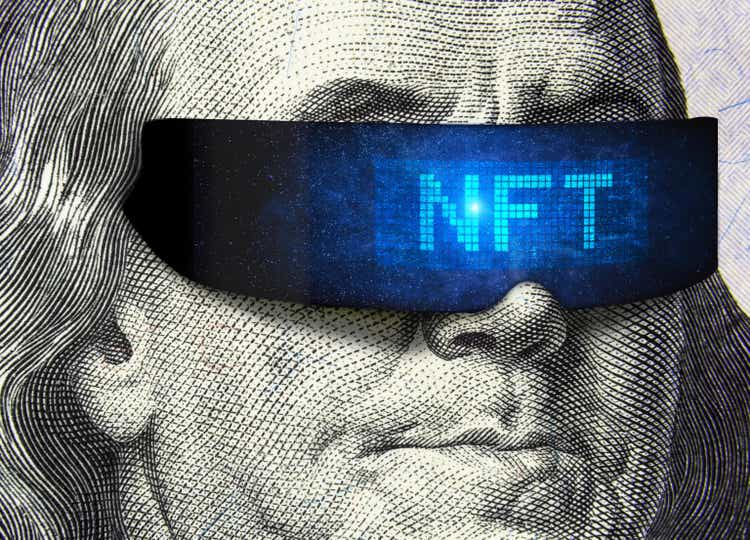
scaliger/iStock via Getty Images
In recent weeks, one of the best performing digital assets in the broader market has been Stacks (STX-USD). After rising from just $0.21 at the end of 2022 and all the way to $0.97 on Monday, STX has nearly quintupled in just one questions in a few weeks. Surely there is a basic story behind this move, right?
What are Stacks?
How one should classify the Stacks blockchain is actually a point of some debate among crypto enthusiasts. There are some who say it is a layer 2 scaling chain built on top of Bitcoin (BTC-USD). And there are others who say it’s a “side chain” and not a true layer 2 like Bitcoin’s Lightning Network. The main sticking point from those who say it is a sidechain seems to be the existence of the STX token. Lightning uses BTC to scale instead of one native coin which is why the L2 designation does not seem to be relevant.
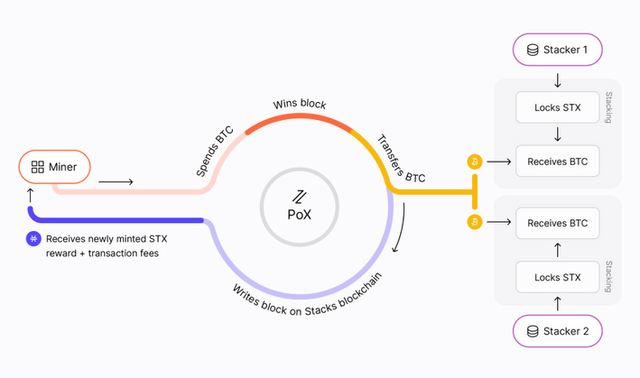
Stacks.co
From a mechanical point of view, the Stacks blockchain uses the Bitcoin miners and what is essentially a BTC deposit model called “proof of transfer” to generate BTC returns for STX holders and Stacks network security. The model has come under scrutiny because it asks Bitcoin miners to use BTC to “bid” on the STX block reward. This could theoretically be a problem for Stacks if the STX token falls in price too quickly against BTC. This scenario may prevent bidding of BTC for STX returns if the real return is negative.
Functionally, Stacks is a smart contract blockchain that enables DeFi, NFTs and domain services. Stacks also has something called “City Coins” which are designed to allow market participants to bet on specific jurisdictions. I will withhold my personal comment on City Coins as I believe the performance of MiamiCoin speaks for itself.
The NFT narrative
The main driver of the recent rally in STX appears to be the emergence of NFTs on Bitcoin as an idea. The ability to create NFTs backed by Bitcoin is a key selling point from the Stacks website:
As with fungible tokens, NFTs on the Stacks blockchain are created with Clarity smart contracts. Because of the relationship between Stacks and Bitcoin, NFTs created on Stacks settle and are secured by Bitcoin.
There is some legitimacy to the notion that Bitcoin will develop a larger NFT ecosystem, as we have already seen a large increase in NFTs minted on Bitcoin blocks through the Ordinals protocol:
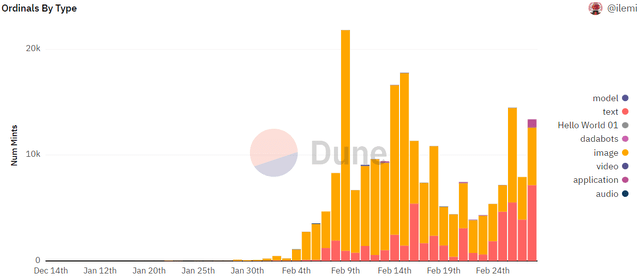
Ordinal Mints (Dune Analytics/ilemi)
Since launch, approximately a quarter of a million Ordinals NFTs have been minted on Bitcoin. However, what is interesting is that Ordinals and Stacks have nothing to do with each other. Ordinals is a protocol that uses Taproot to create NFTs using Bitcoin’s block space. The Ordinals protocol never touches stacks or the STX token. Still, it seems that STX can gather because of Ordinals despite no direct connection with that protocol.
Stacks Network
As for Stacks, the network growth of that chain has been much less evident. According to the Stacks website, the protocol has over $400 million in TVL, but that number is benefiting from the increase in the USD price of the original STX token. When measured in STX, the “cycles”, or stacking periods, have actually seen steady declines in STX that have been stacked back to cycle 46:
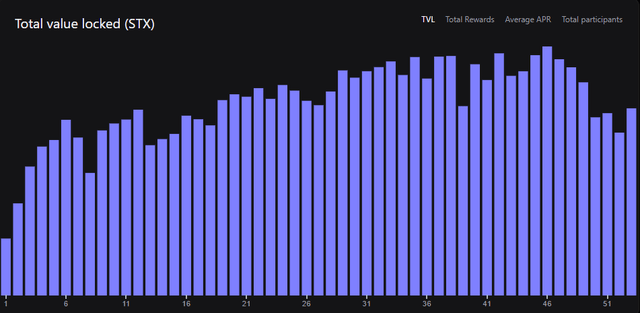
STX TVL (Stacking.Club)
In fact, the last completed cycle (number 52) had only 357 million STX tokens stacked, the lowest since cycle 15. In that cycle, there were 153 stackers. This appears to be a continuation of a larger trend down in the number of stackers over time.
| Average | Stacked | Stackers | Miners |
|---|---|---|---|
| Q4-21 | 421.8m STX | 222 | 6 |
| Q1-22 | 449.6m STX | 213 | 7 |
| Q2-22 | 498.6m STX | 199 | 7 |
| Q3-33 | 493.3m STX | 184 | 7 |
| Q4-22 | 511.2m STX | 168 | 8 |
Source: Messari
Messari’s recently published Stacks note shows some additional issues. With only 8 Bitcoin miners participating last quarter and slow growth, there are centralization concerns at the beginning of the Stacks network. But still, I’d be more concerned about the dwindling number of stackers than anything else.
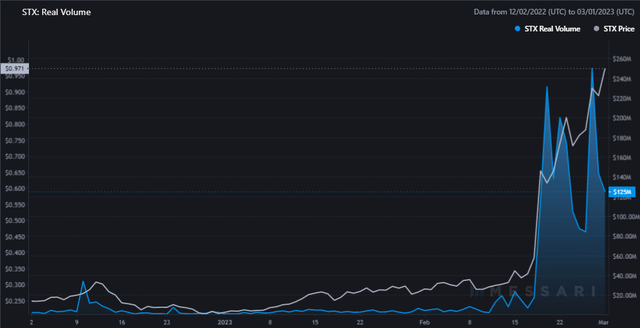
Messari
The increase in real volume reported by Messari combined with the decrease in the number of STX making it into stacking cycles seems to confirm the idea that the recent activity in the price of STX has more to do with speculation than anything else.
That said, it’s an interesting development that Stack’s blockchain is expected to see a major technical improvement this year. In December, the Stacks team announced the “Nakamoto release” and the sBTC token. One of the main limitations of Stacks is its reliance on Bitcoin blocks for transaction settlement. With the Nakamoto release, Stacks will be able to process transactions between Bitcoin blocks for a much faster chain that still benefits from finality on the Bitcoin main layer. The sBTC token is similar to Wrapped Bitcoin (WBTC-USD) as it will allow Bitcoin-connected DeFi activity on the Stacks blockchain. However, unlike WBTC, sBTC will not require a centralized custodian.
Risks: Venture Capital Coin
There is quite a large amount of venture capital money behind Stacks which is sometimes frowned upon in certain cryptocurrency circles. Some of the Stacks backers include Digital Currency Group, the Winklevoss twins and many others:
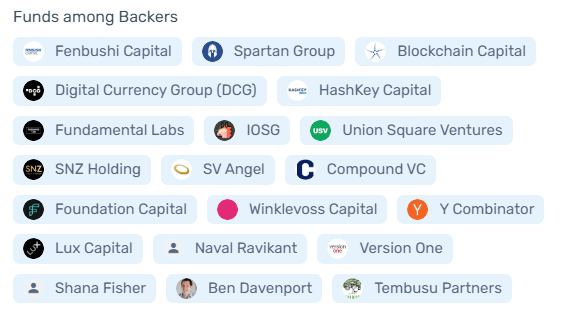
Stackers Backers (CryptoRank)
According to CryptoRank, Stacks has raised over $64 million between a seed round, additional funding round, private token sale and ICO. And this estimate does not include the value of a strategic funding round that took place in July 2019. Crunchbase has the estimate closer to $94 million in total VC funding. The bottom line is that there is a non-zero percent VC dump risk in STX. I personally don’t see alignment with larger players as a total net negative, but the possibility of exit liquidity is always something to keep in mind when exploring these types of assets. VCs are very capable of being wrong. Just look at FTX (FTT-USD).
Summary
There is a notable block reward problem facing Bitcoin in the long term that will likely need to be solved in one of two ways; either through a change to the network that enables new BTC issuance via block reward or through a large increase in the transaction fees paid to miners. The first option is likely a non-starter. Without a huge increase in the price of BTC, dollar-denominated value of revenue from chain transactions would have to come from real network tools. This would mean BTC would have to be moved around and not HODL.
This is why there has been some growing acceptance of the idea that Bitcoin will likely need to accept BTC fees paid from things like NFTs and DeFi to justify miner participation. I’d say we’re still a long way from knowing if Stacks is really the answer Bitcoins block reward problem, but it’s an interesting idea nonetheless. Still, I wouldn’t chase the idea at today’s STX price.
Like just about everything else in crypto, STX appears to be more of an idea at this point than a thriving ecosystem built on Bitcoin’s network security. There is nothing wrong with taking a chance on an idea that has yet to manifest, but there is some risk in doing so. I would probably avoid taking a chance on an idea after it has already accumulated 400% in just a few weeks. STX is probably one to watch from the sidelines for a while.
Editor’s Note: This article covers one or more microcap stocks. Be aware of the risks associated with these stocks.


